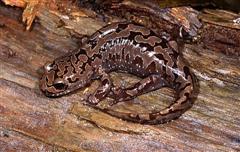Salamander - Giant Coastal
Giant Pacific Salamander, Oregon Giant Salamander Scientific Name: Dicamptodon tenebrosus
Sat, 23rd November, 2024 - 12:37 pm GMT
Sponsor Ads:

Alternative Name
Giant Pacific Salamander, Oregon Giant Salamander Scientific Name: Dicamptodon tenebrosusBasic Info
The Coastal Giant Salamander is one of the largest terrestrial salamanders, and grows to a length between 13 and 14 inches. About 7 inches of that length is made up by the salamander's tail. Generally, Coastal Giant Salamanders have smooth black or dark brown skin, mottled with golden to gray colored spots. The legs are strong and the bodies and heads appear thick. Their gill structures tend to be short. Coastal Giant Salamanders may remain in a larval (aquatic) stage for their entire lives. This is known as neoteny. Coastal Giant Salamanders need several seasons of growth before they may become sexually mature.
Health
Breeding Coastal Giant Salamanders generally breed in cold, fast-moving streams. They often lay about 75 to 100 eggs, which are hidden in some sort of protected chamber. This could even be the gravel bottom of the waterway in which they are laid. Generally, developing eggs have been found from spring to fall, so it would indicate that the breeding season for the Coastal Giant Salamander is quite extensive.Habitat
Generally, Coastal Giant Salamanders prefer cold waters and are often found in mountainous or forested regions. They reside in or around streams or lakes.Behavior
One of the only salamanders capable of vocalizing, the Coastal Giant Salamander can actually bark! These amazing animals grow to a formidable size, but due to their secretive habits, are not often seen. Coastal Giant Salamanders are generally ground or water dwellers, although they climb shrubs or trees on occasion. These salamanders are mostly nocturnal, though they may be active during the day in periods of heavy rainfall. Generally, Coastal Giant Salamanders burrow or remain under leaf litter during most of the year. When alarmed or injured, the Coastal Giant Salamander can produce a low bark much like the yelp of a dog! They may bite in their defense, and they have powerful jaws. Generally, the Coastal Giant Salamander eats small animals like earthworms, snails, snakes, mice, shrews, or other amphibians. Once called the Pacific Giant Salamander along with D. ensatus, D. tenebrosus is now considered a separate species and is commonly called the Coastal Giant or Oregon Giant Salamander. Although they may be quite common in some areas, it may be difficult to find Coastal Giant Salamanders, because they spend so much time submerged or hidden. Logging or other activities that stir up streambeds may cause problems for Coastal Giant Salamanders, as they can be sensitive to mud and silt.Origin
Pacific NorthwestHistory
They are native to North America's Pacific Northwest region, and may be found in the United States in California, Washington, and Oregon in addition to Canada's British Columbia.Common Foods
feeds primarily on insects, earthworms, small rodents, small animals.Sponsor Ads:
I've begun to wonder if we wouldn't also regard spelunkers as desperate criminals if AT&T owned all the caves. -- John Perry Barlow
Salamander - Giant Coastal
Coded by: BGID® | ALL RIGHTS RESERVED Copyright © 2000-2024
Disclaimer | Privacy | Report Errors / Contact | Credits



 Beware the new Naval power, they are planning to come on stream with big naval might to match their ground forces. Chinese Aircraft Carrier - Chinese Navy
Beware the new Naval power, they are planning to come on stream with big naval might to match their ground forces. Chinese Aircraft Carrier - Chinese Navy  versus
versus 
 versus
versus  This Thread is about the North Korean Military itself - the kind of army, navy, and air force they have.
This Thread is about the North Korean Military itself - the kind of army, navy, and air force they have. 
 versus
versus  versus
versus 
 versus
versus  versus
versus